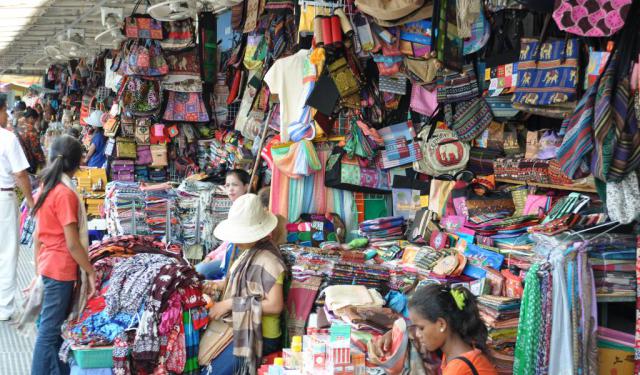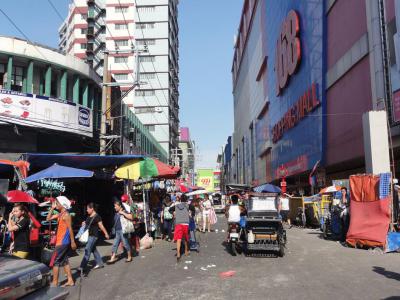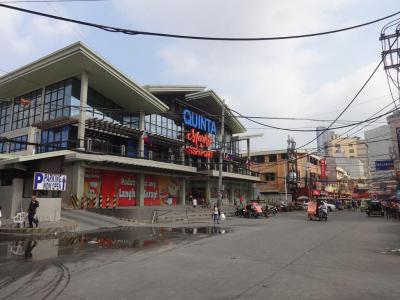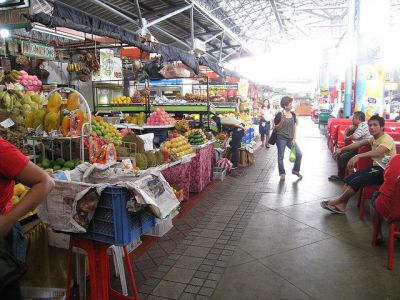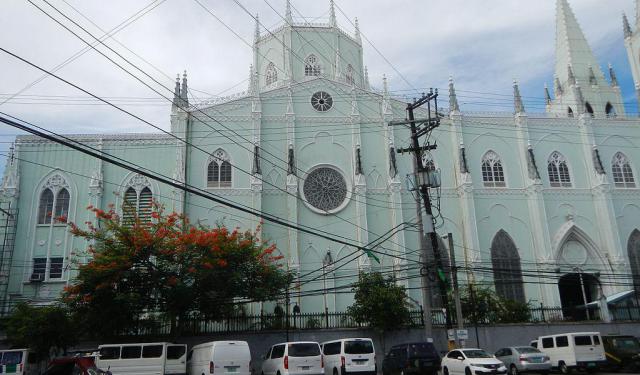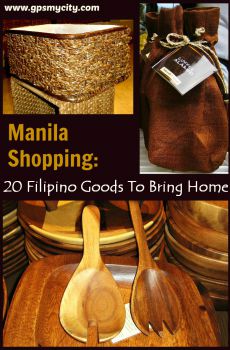Traditional Markets (Self Guided), Manila
Traditional markets showcase a unique aspect of life in any city. The ones featured in this walk offer a glance into the authentic life and habits of Manila’s people and play a vital role in the Philippines' capital's economic and cultural landscape. Traditionally, local markets sell a broader range of products than regular shops can provide: from veggies and fruits to dried fish and so on.
For real bargains, nothing beats Divisoria Market, or "Divi", as Manila residents call it. In this sprawling marketplace, you can find just about anything under the sun, from clothing and accessories to home goods and fresh produce. The action is particularly feverish at weekends, and you'll need at least a full morning – or full afternoon – to do it justice.
Quinta Market, located in Quiapo, is renowned for its fresh seafood and exotic ingredients. It's a paradise for food enthusiasts looking to explore Filipino cuisine. The stalls overflow with a dazzling array of fish, crabs, and other marine delicacies, making it a must-visit for seafood lovers. The vibrant colors and savory aromas make Quinta Market a sensory delight.
Central Market is one of the oldest markets in Manila. It's a melting pot of cultures, offering a diverse range of products, from fresh produce to textiles and handicrafts. Here, you can immerse yourself in the rich Filipino culture and engage with friendly vendors who are happy to share their stories and traditions.
The narrow alleyways and bustling stalls of Manila's markets create a vibrant atmosphere that can be overwhelming, and the thrill of discovering hidden treasures is what keeps people coming back. As in other crowded areas, you should be careful with valuables in your pockets, and try wearing your backpack on your front.
To experience the essence of these marketplaces, where you can connect with the heart and soul of Manila, we encourage you to take this self-guided shopping tour. Dive into the lively atmosphere, sample the delicious street food, and haggle for unique souvenirs!
For real bargains, nothing beats Divisoria Market, or "Divi", as Manila residents call it. In this sprawling marketplace, you can find just about anything under the sun, from clothing and accessories to home goods and fresh produce. The action is particularly feverish at weekends, and you'll need at least a full morning – or full afternoon – to do it justice.
Quinta Market, located in Quiapo, is renowned for its fresh seafood and exotic ingredients. It's a paradise for food enthusiasts looking to explore Filipino cuisine. The stalls overflow with a dazzling array of fish, crabs, and other marine delicacies, making it a must-visit for seafood lovers. The vibrant colors and savory aromas make Quinta Market a sensory delight.
Central Market is one of the oldest markets in Manila. It's a melting pot of cultures, offering a diverse range of products, from fresh produce to textiles and handicrafts. Here, you can immerse yourself in the rich Filipino culture and engage with friendly vendors who are happy to share their stories and traditions.
The narrow alleyways and bustling stalls of Manila's markets create a vibrant atmosphere that can be overwhelming, and the thrill of discovering hidden treasures is what keeps people coming back. As in other crowded areas, you should be careful with valuables in your pockets, and try wearing your backpack on your front.
To experience the essence of these marketplaces, where you can connect with the heart and soul of Manila, we encourage you to take this self-guided shopping tour. Dive into the lively atmosphere, sample the delicious street food, and haggle for unique souvenirs!
How it works: Download the app "GPSmyCity: Walks in 1K+ Cities" from Apple App Store or Google Play Store to your mobile phone or tablet. The app turns your mobile device into a personal tour guide and its built-in GPS navigation functions guide you from one tour stop to next. The app works offline, so no data plan is needed when traveling abroad.
Traditional Markets Map
Guide Name: Traditional Markets
Guide Location: Philippines » Manila (See other walking tours in Manila)
Guide Type: Self-guided Walking Tour (Sightseeing)
# of Attractions: 3
Tour Duration: 1 Hour(s)
Travel Distance: 3.0 Km or 1.9 Miles
Author: nicole
Sight(s) Featured in This Guide:
Guide Location: Philippines » Manila (See other walking tours in Manila)
Guide Type: Self-guided Walking Tour (Sightseeing)
# of Attractions: 3
Tour Duration: 1 Hour(s)
Travel Distance: 3.0 Km or 1.9 Miles
Author: nicole
Sight(s) Featured in This Guide:
- Divisoria Market
- Quinta Market
- Central Market
1) Divisoria Market
The Divisoria Market is one of the best places to shop in Manila. It is often called the “mother of all markets in Manila” with a reputation as “the Mecca of value shopping” for the variety of products and the low prices it offers.
Unlike other markets, the Divisoria Market sells almost everything from jewelry to footwear, souvenirs to school items, electronics to foods all at wholesale prices. The market is also very popular for textiles. This colossal and chaotic market is located in the heart of the city, surrounded by Juan Luna, Santo Cristo, Recto and Comercio street.
During the Spanish rule, the non-Christian Chinese merchants were not allowed to trade inside the walled city. The Divisoria market was initially a small community of Chinese merchants which then expanded and blossomed into a commercial center and a major trade center in the 1990s.
Today, the market has several malls like the 168 mall, Meisic mall, Tutuban Center mall (former Tutuban Central Station) and the Divisoria Mall. Along with all the stores and malls, the Market also has a food hub where one can enjoy a variety of cuisines including the local Filipino food and Chinese food. Although, the market is busy year around, it is especially crowded before Christmas and around the time when schools reopen.
Unlike other markets, the Divisoria Market sells almost everything from jewelry to footwear, souvenirs to school items, electronics to foods all at wholesale prices. The market is also very popular for textiles. This colossal and chaotic market is located in the heart of the city, surrounded by Juan Luna, Santo Cristo, Recto and Comercio street.
During the Spanish rule, the non-Christian Chinese merchants were not allowed to trade inside the walled city. The Divisoria market was initially a small community of Chinese merchants which then expanded and blossomed into a commercial center and a major trade center in the 1990s.
Today, the market has several malls like the 168 mall, Meisic mall, Tutuban Center mall (former Tutuban Central Station) and the Divisoria Mall. Along with all the stores and malls, the Market also has a food hub where one can enjoy a variety of cuisines including the local Filipino food and Chinese food. Although, the market is busy year around, it is especially crowded before Christmas and around the time when schools reopen.
2) Quinta Market
Quinta Market, with its rich history and modern transformation, holds a significant place in the heart of Manila. Established in 1851 by the Spanish colonial government, it shares its birth year with the notable Divisoria Market. Initially designed to serve the affluent families residing in Quiapo, Quinta Market quickly ascended to prominence, becoming the central market of the City of Manila. By the early 20th century, it was recognized as one of the most crucial markets in the city, a testament to its enduring appeal and significance in the local community.
In a significant evolution of its infrastructure, the old market structure was demolished in 2017 to make way for a modern two-story facility. This transformation was not just physical; it symbolized the market's adaptability and resilience through the ages, blending tradition with contemporary needs. Today, Quinta Market is a bustling hub that houses 279 registered vendors. These vendors have a historical connection to the market, being the same individuals who operated in the old market before its reconstruction. This continuity ensures that the market's rich heritage is preserved, even as it moves forward in a modern setting.
At Quinta Market, visitors are greeted with an array of fresh produce and a variety of foods. The market is renowned for its fish, meat, vegetables, fruits, and other food items. What makes this market unique is the availability of already-cooked meals, prepared from the fresh products available within the market itself. This feature not only showcases the versatility of the vendors but also offers a convenient and delicious option for shoppers looking for ready-to-eat meals.
In a significant evolution of its infrastructure, the old market structure was demolished in 2017 to make way for a modern two-story facility. This transformation was not just physical; it symbolized the market's adaptability and resilience through the ages, blending tradition with contemporary needs. Today, Quinta Market is a bustling hub that houses 279 registered vendors. These vendors have a historical connection to the market, being the same individuals who operated in the old market before its reconstruction. This continuity ensures that the market's rich heritage is preserved, even as it moves forward in a modern setting.
At Quinta Market, visitors are greeted with an array of fresh produce and a variety of foods. The market is renowned for its fish, meat, vegetables, fruits, and other food items. What makes this market unique is the availability of already-cooked meals, prepared from the fresh products available within the market itself. This feature not only showcases the versatility of the vendors but also offers a convenient and delicious option for shoppers looking for ready-to-eat meals.
3) Central Market
Central Market, nestled north of the iconic Quiapo Church along Andalucia Street in Manila, presents a bustling hub of commerce and culture that captivates both locals and tourists alike. This expansive marketplace is characterized by its somewhat modest appearance, yet it holds within a treasure trove of items that spans the spectrum of daily needs and unique finds. Shoppers can explore an extensive range of products including clothing, military uniforms, a variety of knives and hardware tools, an array of food items alongside fresh vegetables and fruits, footwear, toys, intricately crafted handmade jewelry, and an assortment of souvenirs that encapsulate the rich Filipino heritage.
What sets the Central Market apart is not just its vast selection but the organization within its sprawling space. The market is intelligently segregated into different areas, making the shopping experience more navigable and enjoyable. This layout allows customers to easily locate specific categories of goods, saving time and enhancing the overall market visit. The diversity of products available is truly astonishing, catering to virtually every possible need and desire. Moreover, the items are priced reasonably, making it a popular destination for those seeking quality goods without the hefty price tag.
Central Market in Manila is more than just a place to shop; it is a vibrant representation of the city's bustling life and diversity. Its ability to offer "everything" under one roof, coupled with the convenience of its organized space, makes it a must-visit locale for anyone looking to delve into the local culture, find everyday essentials, or search for unique items that are hard to find elsewhere.
What sets the Central Market apart is not just its vast selection but the organization within its sprawling space. The market is intelligently segregated into different areas, making the shopping experience more navigable and enjoyable. This layout allows customers to easily locate specific categories of goods, saving time and enhancing the overall market visit. The diversity of products available is truly astonishing, catering to virtually every possible need and desire. Moreover, the items are priced reasonably, making it a popular destination for those seeking quality goods without the hefty price tag.
Central Market in Manila is more than just a place to shop; it is a vibrant representation of the city's bustling life and diversity. Its ability to offer "everything" under one roof, coupled with the convenience of its organized space, makes it a must-visit locale for anyone looking to delve into the local culture, find everyday essentials, or search for unique items that are hard to find elsewhere.
Walking Tours in Manila, Philippines
Create Your Own Walk in Manila
Creating your own self-guided walk in Manila is easy and fun. Choose the city attractions that you want to see and a walk route map will be created just for you. You can even set your hotel as the start point of the walk.
Historical Buildings Walking Tour
Manila’s long history results from its situation as a natural port in a huge bay. With the Spanish conquest of the Philippines in the 16th century, it became united, along with Mexico City and Madrid, into the first truly globalised trade system. Intramuros, Manila’s old walled Spanish town, stood for 350 years before World War II came, and still houses many of the historic buildings.
For a... view more
Tour Duration: 1 Hour(s)
Travel Distance: 2.5 Km or 1.6 Miles
For a... view more
Tour Duration: 1 Hour(s)
Travel Distance: 2.5 Km or 1.6 Miles
Historical Churches Walking Tour
International surveys have repeatedly ranked Filipinos among the world’s most religious people. The archipelago’s colonization and evangelization by the Spanish, started in 1565, has left Manila with many shrines and churches sprawled around its streets, despite the destructions by wars and natural disasters. Some of these old churches are especially attractive due to their delicate mixture of... view more
Tour Duration: 2 Hour(s)
Travel Distance: 3.9 Km or 2.4 Miles
Tour Duration: 2 Hour(s)
Travel Distance: 3.9 Km or 2.4 Miles
Manila Introduction Walking Tour
The capital of the Philippines, Manila was officially founded in 1571 by Spanish conquistador Miguel López de Legazpi. However, an organized polity, called Maynila (meaning "where indigo is found" in Tagalog), existed on the site since as early as 1258.
The earliest human life in the area dates to 3000 BCE, but much of the existing constructions found around the city were created... view more
Tour Duration: 2 Hour(s)
Travel Distance: 2.3 Km or 1.4 Miles
The earliest human life in the area dates to 3000 BCE, but much of the existing constructions found around the city were created... view more
Tour Duration: 2 Hour(s)
Travel Distance: 2.3 Km or 1.4 Miles
Useful Travel Guides for Planning Your Trip
Manila Shopping: 20 Filipino Goods To Bring Home
An archipelago of 7,000+ islands, The Philippines is a diverse nation populated by different tribes, each having their own culture and traditions. In Manila, one can find a whole lot of things worth keeping as a Filipino memento; it just might take one a little while to figure out what's best...
The Most Popular Cities
/ view all
